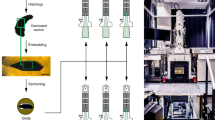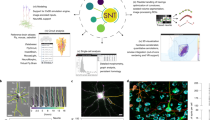Abstract
Currently only electron microscopy provides the resolution necessary to reconstruct neuronal circuits completely and with single-synapse resolution. Because almost all behaviors rely on neural computations widely distributed throughout the brain, a reconstruction of brain-wide circuits—and, ultimately, the entire brain—is highly desirable. However, these reconstructions require the undivided brain to be prepared for electron microscopic observation. Here we describe a preparation, BROPA (brain-wide reduced-osmium staining with pyrogallol-mediated amplification), that results in the preservation and staining of ultrastructural details throughout the brain at a resolution necessary for tracing neuronal processes and identifying synaptic contacts between them. Using serial block-face electron microscopy (SBEM), we tested human annotator ability to follow neural ‘wires’ reliably and over long distances as well as the ability to detect synaptic contacts. Our results suggest that the BROPA method can produce a preparation suitable for the reconstruction of neural circuits spanning an entire mouse brain.
This is a preview of subscription content, access via your institution
Access options
Subscribe to this journal
Receive 12 print issues and online access
$259.00 per year
only $21.58 per issue
Buy this article
- Purchase on Springer Link
- Instant access to full article PDF
Prices may be subject to local taxes which are calculated during checkout




Similar content being viewed by others
References
Denk, W., Briggman, K.L. & Helmstaedter, M. Structural neurobiology: missing link to a mechanistic understanding of neural computation. Nat. Rev. Neurosci. 13, 351–358 (2012).
Lichtman, J.W. & Denk, W. The big and the small: challenges of imaging the brain's circuits. Science 334, 618–623 (2011).
Jarrell, T.A. et al. The connectome of a decision-making neural network. Science 337, 437–444 (2012).
Briggman, K.L., Helmstaedter, M. & Denk, W. Wiring specificity in the direction-selectivity circuit of the retina. Nature 471, 183–188 (2011).
Bock, D.D. et al. Network anatomy and in vivo physiology of visual cortical neurons. Nature 471, 177–182 (2011).
Knott, G., Marchman, H., Wall, D. & Lich, B. Serial section scanning electron microscopy of adult brain tissue using focused ion beam milling. J. Neurosci. 28, 2959–2964 (2008).
Mikula, S., Binding, J. & Denk, W. Staining and embedding the whole mouse brain for electron microscopy. Nat. Methods 9, 1198–1201 (2012).
Li, A. et al. Micro-optical sectioning tomography to obtain a high-resolution atlas of the mouse brain. Science 330, 1404–1408 (2010).
Willingham, M.C. & Rutherford, A.V. The use of osmium-thiocarbohydrazide-osmium (OTO) and ferrocyanide-reduced osmium methods to enhance membrane contrast and preservation in cultured cells. J. Histochem. Cytochem. 32, 455–460 (1984).
Deerinck, T.J. et al. Enhancing serial block-face scanning electron microscopy to enable high resolution 3-D nanohistology of cells and tissues. Microsc. Microanal. 16, 1138–1139 (2010).
Zweens, J., Frankena, H., Rispens, P. & Zijlstra, W.G. Determination of extracellular fluid volume in the dog with ferrocyanide. Pflugers Arch. 357, 275–290 (1975).
Van Harreveld, A., Crowell, J. & Malhotra, S.K. A study of extracellular space in central nervous tissue by freeze-substitution. J. Cell Biol. 25, 117–137 (1965).
Thorne, R.G. & Nicholson, C. In vivo diffusion analysis with quantum dots and dextrans predicts the width of brain extracellular space. Proc. Natl. Acad. Sci. USA 103, 5567–5572 (2006).
Van Harreveld, A. in The Structure and Function of Nervous Tissue (ed. Bourne, G.H.) Ch. 10, 447–511 (Academic Press, 1972).
Cragg, B. Preservation of extracellular space during fixation of the brain for electron microscopy. Tissue Cell 12, 63–72 (1980).
Rivlin, P.K. & Raymond, P.A. Use of osmium tetroxide-potassium ferricyanide in reconstructing cells from serial ultrathin sections. J. Neurosci. Methods 20, 23–33 (1987).
Karnovsky, M.J. Use of ferrocyanide-reduced osmium tetroxide in electron microscopy. Proc. Am. Soc. J. Cell Biol. 51, 146a (1971).
Alexander, R., Ko, E.C.F., Mac, Y.C. & Parker, A.J. Solvation of ions. XI. Solubility products and instability constants in water methanol, formamide, dimethylformamide, dimethylacetamide, dimethyl sulfoxide, acetonitrile, and hexamethylphosphorotriamide. J. Am. Chem. Soc. 89, 3703–3712 (1967).
Denk, W. & Horstmann, H. Serial block-face scanning electron microscopy to reconstruct three-dimensional tissue nanostructure. PLoS Biol. 2, e329 (2004).
Bahr, G.F. Osmium tetroxide and ruthenium tetroxide and their reactions with biologically important substances: electron stains III. Exp. Cell Res. 7, 457–479 (1954).
Hayat, M.A. Principles and Techniques of Electron Microscopy: Biological Applications 4th edn. (Cambridge Univ. Press, 2000).
Greedan, J.E., Willson, D.B. & Haas, T.E. Metallic nature of osmium dioxide. Inorg. Chem. 7, 2461–2463 (1968).
Eberle, A.L. et al. High-resolution, high-throughput imaging with a multibeam scanning electron microscope. J. Microsc. 10.1111/jmi.12224 (27 January 2015).
Titze, B. & Denk, W. Automated in-chamber specimen coating for serial block-face electron microscopy. J. Microsc. 250, 101–110 (2013).
Pfenninger, K.H. The cytochemistry of synaptic densities. I. An analysis of the bismuth iodide impregnation method. J. Ultrastruct. Res. 34, 103–122 (1971).
Tapia, J.C. et al. High-contrast en bloc staining of neuronal tissue for field emission scanning electron microscopy. Nat. Protoc. 7, 193–206 (2012).
Helmstaedter, M., Briggman, K.L. & Denk, W. High-accuracy neurite reconstruction for high-throughput neuroanatomy. Nat. Neurosci. 14, 1081–1088 (2011).
Tomassy, G.S. et al. Distinct profiles of myelin distribution along single axons of pyramidal neurons in the neocortex. Science 344, 319–324 (2014).
Hayworth, K.J. et al. Ultrastructurally smooth thick partitioning and volume stitching for large-scale connectomics. Nat. Methods 10.1038/nmeth.3292 (16 February 2015).
Hayworth, K.J., Kasthuri, N., Schalek, R. & Lichtman, J.W. Automating the collection of ultrathin serial sections for large volume TEM reconstructions. Microsc. Microanal. 12, 86–87 (2006).
Siegel, S.M. & Siegel, B.Z. Autoxidation of pyrogallol: general characteristics and inhibition by catalase. Nature 181, 1153–1154 (1958).
Spurr, A.R. A low-viscosity epoxy resin embedding medium for electron microscopy. J. Ultrastruct. Res. 26, 31–43 (1969).
Binding, J., Mikula, S. & Denk, W. Low-dosage maximum-a-posteriori focusing and stigmation (MAPFoSt). Microsc. Microanal. 19, 38–55 (2013).
Gundersen, H.J.G. et al. The new stereological tools: disector, fractionator, nucleator and point sampled intercepts and their use in pathological research and diagnosis. APMIS 96, 857–881 (1988).
Fiala, J.C. & Harris, K.M. Extending unbiased stereology of brain ultrastructure to three-dimensional volumes. J. Am. Med. Inform. Assoc. 8, 1–16 (2001).
Acknowledgements
We thank K.L. Briggman, K. Hayworth and S.K. Mikula for discussions; J. Bollmann, J. Kornfeld and S.K. Mikula for comments on the manuscript; A. Scherbarth, S.K. Mikula, M. Mueller, C. Roome, R. Shoeman, B. Titze and J. Tritthardt for technical support, D. Zeidler for providing the multi-beam images, J. Kornfeld, I. Sonntag, and F. Svara for help with traceability analysis and tracer organization; and D. Bornhorst, A. Greiss, U. Häusler, J. Hügle, A. Ivanova, F. Kaufhold, C. Kehrel, P. Kroemer, J. Loeffler, L. Muenster, S. Oberrauch, J. Phillip, N. Reisert, N. Scherer, F. Scheu and M. Webeler for tracing neurites. This work was supported by the Max Planck Society.
Author information
Authors and Affiliations
Contributions
S.M. and W.D. conceived of the project and wrote the paper. S.M. designed the study, carried out the experiments and analyzed the data.
Corresponding author
Ethics declarations
Competing interests
W.D. receives license income for SBEM technology (Gatan, 3View).
Integrated supplementary information
Supplementary Figure 1 ROTO staining and ultrastructural preservation over different depths.
SEM images for ROTO-prepared samples without, (a-e), and with, (f-i), extracellular space (ECS) preservation. Locations for high-resolution images indicated in the corresponding low-resolution scans. Imaging parameters are 440 nm pixel size, 2.8 kV, 100 pA, and 0.0064 e-/nm2 in a and f, 5 nm pixel size, 2.8 kV, 300 pA, and 600 e-/nm2 in b-e, and 10 nm pixel size, 2.8 kV, 100 pA, and 100 e-/nm2 in g-i. Scales bars are 100 μm in a and f, 250 nm in b-e and 500 nm in g-i.
Supplementary Figure 2 Mechanical disruption in large ROTO-prepared samples.
SEM block-face image (220 nm pixel size, 2.8 kV, 100 pA, and 0.0256 e-/nm2) taken from a ROTO sample (with 10% formamide added to the reduced osmium step to increase stain penetration) prepared using an ECS-preserving perfusion medium. The scale bar corresponds to 100 μm.
Supplementary Figure 3 Multibeam SEM imaging of a BROPA-prepared sample.
(a) Schematic of the prototype multi-beam microscope. (b) Image (3.8 nm pixel size, 430 pA, 100 ns pixel dwell time, 470 MPixel/s effective scan rate, 18.6 e-/nm2) of a block-face coated with a thin film of palladium to avoid charging. Each tile corresponds to an image taken by one of the 61 beams that scan the sample simultaneously. (c) Subregions as indicated in b. (d) Subregion from multi-beam SEM image acquired at high current (4.6 nm pixel size, 3 nA, 50 ns pixel dwell time, 755 MPixel/s effective scan rate, 44.2 e-/nm2). The sample is the same as in b. Asymmetric synapse onto a spine head (arrowhead). Scale bars are 10 μm in b and 1 μm in c. Scale bar in c also applies to d.
Supplementary Figure 4 Inter-areal SBEM and neurite traceability.
(a) Complete block-face SEM image (top, 440 nm pixel size, 4 kV, 150 pA, 0.0097 e-/nm2) of a BROPA brain and a higher-magnification view of the region of interest (bottom). The red rectangle shows the approximate extent of a continuous SBEM stack. The normal of the stack images is along the long axis of the rectangle. (b) From the left: surface view of aligned stack; manually identified neuronal (blue) and glial (red) nuclei; neurites emerging from 381 randomly-selected nuclei. 6 of 381 neurons (3 each in cortex and striatum) together with 100 randomly selected external-capsule axons. Note that one of them veers into cortex. (c) Single cortical cell with dendrites (thin blue lines), the initial segment and an ascending collateral (thick red, both unmyelinated), and the descending axon (thin blue line) with nodes of Ranvier (red). Scale bars are 1 mm in a (top), 500 µm in a (bottom), and 40 µm in c.
Supplementary Figure 5 Crack in BROPA sample.
(a) Cracks, generally devoid of epoxy, are occasionally observed in epoxy-embedded BROPA samples (see Supplementary Video 4). (b) High-magnification image of the red asterisk in a. Imaging parameters are 220 nm pixel size, 3.0 kV and 0.29 e-/nm2 in a and 10 nm pixel size, 3.0 kV and 140 e-/nm2 in b. Scale bars are 100 μm in a and 5 μm in b.
Supplementary information
Supplementary Text and Figures
Supplementary Figures 1–5 (PDF 1366 kb)
Supplementary Video 1
Striatum SBEM stack High-magnification striatum SBEM stack (cropped to 6.4 × 5.1 × 15.8 micron) showing the dendrite and synapse segmentation from Fig. 3a overlaid onto the original data. (MOV 11250 kb)
Supplementary Video 2
Somatosensory cortex SBEM stack High-magnification somatosensory cortex SBEM stack (cropped to 6.4 × 5.1 × 15.8 micron). (MOV 17593 kb)
Supplementary Video 3
External capsule SBEM stack High-magnification external capsule SBEM stack (cropped to 6.4 × 5.1 × 15.8 micron). (MOV 17648 kb)
Supplementary Video 4
X-ray microCT fly-through X-ray microCT fly-through of whole-brain in Fig. 4a. (MOV 4674 kb)
Supplementary Data
Multi-page tiff stacks of synapses corresponding to Fig. 3b,c and the inset of c. (ZIP 9112 kb)
Supplementary Software
Matlab code used for the neurite traceability analysis (RESCOP) provided as a compressed folder. See “readme” file in folder. (ZIP 171 kb)
Rights and permissions
About this article
Cite this article
Mikula, S., Denk, W. High-resolution whole-brain staining for electron microscopic circuit reconstruction. Nat Methods 12, 541–546 (2015). https://doi.org/10.1038/nmeth.3361
Received:
Accepted:
Published:
Issue Date:
DOI: https://doi.org/10.1038/nmeth.3361
This article is cited by
-
High-contrast en bloc staining of mouse whole-brain and human brain samples for EM-based connectomics
Nature Methods (2023)
-
Spatial Transcriptomics-correlated Electron Microscopy maps transcriptional and ultrastructural responses to brain injury
Nature Communications (2023)
-
Neuropathologie II: Erkrankungen des zentralen und peripheren Nervensystems
Die Pathologie (2023)
-
Volume electron microscopy
Nature Reviews Methods Primers (2022)
-
Functional and multiscale 3D structural investigation of brain tissue through correlative in vivo physiology, synchrotron microtomography and volume electron microscopy
Nature Communications (2022)



